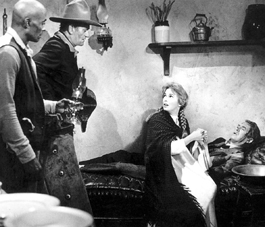home | metro silicon valley index | movies | current reviews | film review

VALANCE OF POWER: Woody Strode, John Wayne, Vera Miles and Jimmy Stewart try to rid Shinbone of Liberty Valance in John Ford's 1962 Western.
The Outside Man
You're never a cowboy until John Wayne says you are
By Richard von Busack
SEEN IN sunset and twilight, the long shadow of John Wayne is still impressive. And the Stanford Theatre's double bill of John Ford's 1962 The Man Who Shot Liberty Valance and Howard Hawk's 1959 Rio Bravo revives two essential films. "I was just paint for the palette of Ford and Hawks," Wayne supposedly said once. Here Wayne stars in two very different Westerns: as the center for a band of misfits in Hawks' Rio Bravo and as half-offscreen catalyst in Ford's Liberty Valance.
To viewers with selective memories, Wayne is remembered as a dauntless unmoving hero. These two movies have more going on than they appear to at first glance. As critic Andrew Sarris writes, "Wayne's most enduring image ... is that of the displaced loner vaguely uncomfortable with the very civilization he is helping to establish and preserve."
Liberty Valance is a Rashomon-style story—we think we know it all, and then we get the real conclusion. Returning to a small town, circa 1910, Ransom Stoddard (Jimmy Stewart), a renowned politician, tells a newspaper editor about his time as a young country lawyer in Shinbone. The place is terrorized by the bandit Liberty Valance (Lee Marvin), the sadistic regulator for the cattle interests. Tom Doniphon (Wayne), a horse rancher, is unimpressed by either this outlandish thug or his guns. Stoddard aims to bring in the bastard using the law; the more practical Donovan thinks this is an idiot scheme and says so.
"The Man Who Shot Liberty Valance clearly stands out as the most important American film of the 1960s," comments Ford scholar Joseph McBride. But if it's a great movie, it shows that the great ones aren't all the way good. Ford made some choices of style that stick in more than a few viewers' throats. The stagy false fronts and archaic-looking black-and-white film were chosen to detach this film and make it a fable; even the pale makeup looks like the white powder applied to old movie stars.
Wayne is so good in this movie because he's outside the movie. His is the part that doesn't fit. He's the one who addresses the calculation of it all: "You talk too much; you think too much" he snarls—a rebuke to actors then and since. If Doniphon is the hero, he's a strange one. After he makes a selfless yet self-destructive choice, he has an astonishing drunk scene followed by an outburst of fury. Wayne's greatness also lies in both the beauty of his nervelessness and in the delicate gesture. Ford always liked to give Wayne flowers to hold. And Vera Miles' Hallie Stoddard, the woman to whom Doniphon gives a flowering cactus, provides the film's brilliantly forked ending. Note Miles' keen disappointment as she watches her husband, Ransom, slap on the mask and become a gabbling politician again, just to impress a flunky on a train! It took me years to understand that "this is the West, Sir ..." wasn't the last scene in the movie.
(Liberty Valance deserves the big-screen treatment, but it is also available in a handsome new two-disc DVD set, released this week in Paramount's Centennial Collection, with commentary by Peter Bogdanovich.)
You can get an easy B in film-theory class for declaring Rio Bravo the first postmodern Western. Rio Bravo is a reaction to High Noon and the first version of 3:10 to Yuma; hating both of those movies, Hawks decided to do without the nerves and fury of the adult Western. He sought efficiency, purpose and lots and lots of humor.
In a Texas border country, a barroom killer (Claude Akins) is under the custody of Wayne's Sheriff John T. Chance. Unfortunately, the accused is the little brother of the local land baron, who proposes to break the man out of jail using his small army of gunmen. To hold the line, Chance deputizes the locals, including a cracked geezer (Walter Brennan, deliriously good) and Dude (Dean Martin), the town drunk. It's as much Rat Pack as rural siege—a Western with more juice than dust in it.
The questions of the use of force now are debated in superhero movies instead of in Westerns. Critic James Rocchi figured that The Dark Knight's ending is a nod to Liberty Valance. And there's an upcoming remake of True Grit scheduled by the Coen brothers. (The 1969 original plays June 5 at the Stanford). Hard to imagine the Coens handling a scene like the one of Wayne's old one-eyed Rooster Cogburn telling a story over a campfire about his own spell running a restaurant in Cairo, Ill., in those days before his temper drove away his wife and son. This scene exemplifies what Sarris means about "the displaced loner"; it was reputedly the actor's all-time favorite. Wayne's leave-taking at the end of True Grit may be his all-time most graceful gesture. Though it's actually a horseman hopping over a fence around a snow-covered cemetery, it looks very much like a man leaping out of a grave on horseback.
![]() THE MAN WHO SHOT LIBERTY VALANCE and RIO BRAVO plays May 22–24 at the Stanford Theatre in Palo Alto.
THE MAN WHO SHOT LIBERTY VALANCE and RIO BRAVO plays May 22–24 at the Stanford Theatre in Palo Alto.
Click Here to Talk About Movies at Metro's New Blog
Send a letter to the editor about this story.
|
|
|
|
|
|
